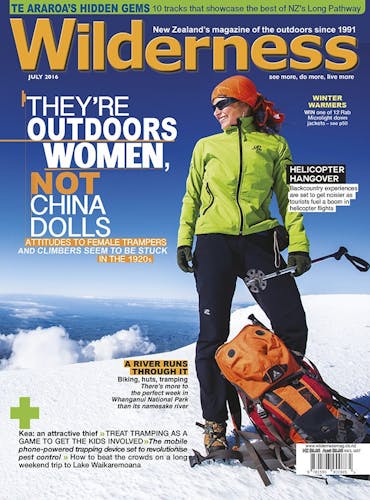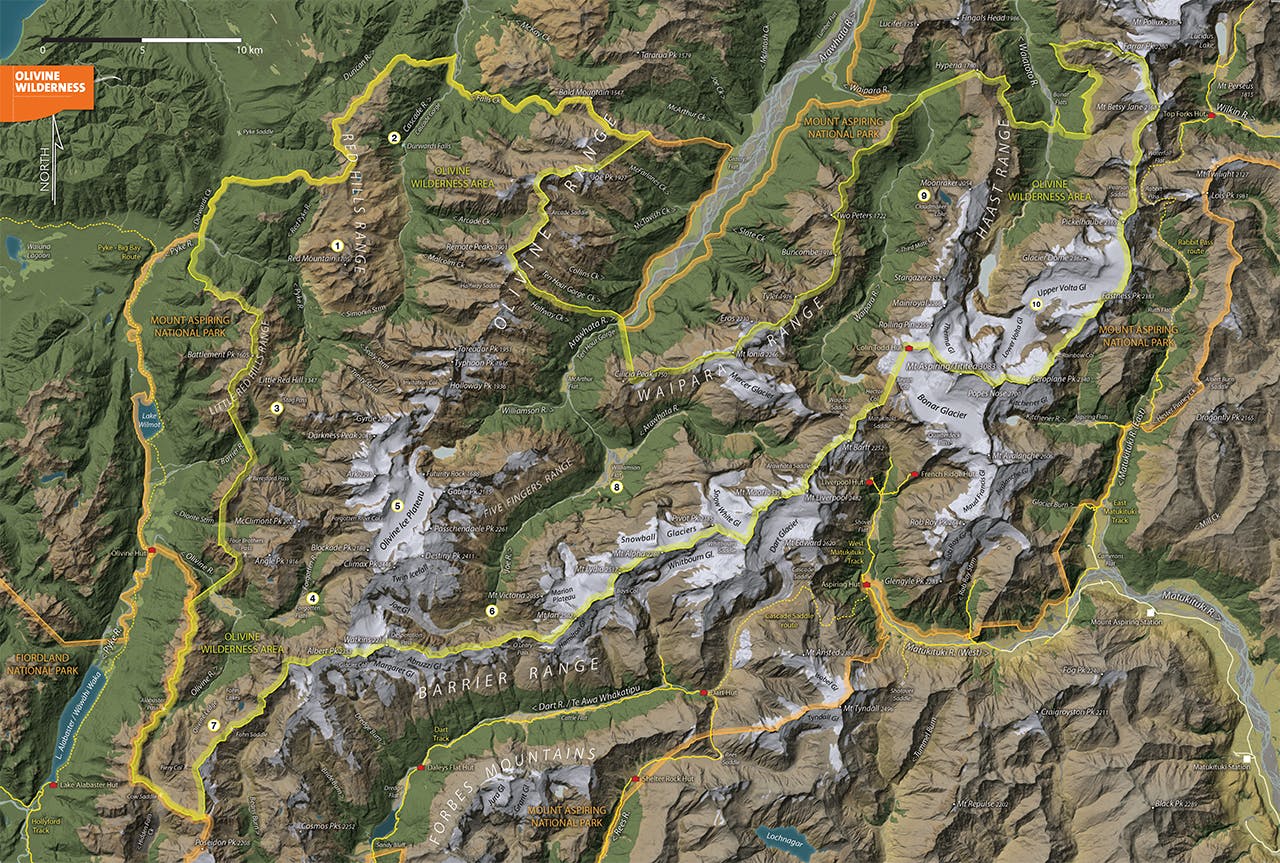The Olivine Wilderness in Mt Aspiring National Park is one of New Zealand’s premier wilderness areas. The landscape here is in grand proportions: ice, mountains, forests, flats and gorges. It is a playground for the fit and adventurous, those looking for big challenges and able to look after themselves on nature’s terms. There are no huts and tracks in the entire area, and air access is not allowed.
For 65km, the boundary runs along the western crest of the Main Divide from above the Rock Burn to the Wilkin. This ‘Land of Beyond’ includes tributaries of the Pyke, Cascade, Arawhata and Waiatoto rivers, and the Red Hills, Olivine and Haast Ranges.
The area is best approached on journeys of a week or more duration. The Five Pass trip would be the most used route (though only a fraction of the route is actually in the Wilderness Area), and one of the easiest. Others use the Beans Burn-Fohn Saddle-Olivine-Forgotten route to the Olivine Ice Plateau and back. There is a nice pass-hopping trip utilising Four Brothers Pass, Beresford Pass and Stag Pass. Things get more serious in the head of the Arawhata and Waiatoto, where access can be long and challenging.
1 Red Mountain
The stark, rough, brick-red rock and unusual barren landscape of Red Mountain provides generally open travel, but the rock is very coarse and hard on fingers and boots. The best approach to the peak is up a gully from the north. There is good camping near tarns west of Peridot Creek.
2 Durwards Falls
These spectacular falls, where the whole river plunges 50m over a fault scarp into a canyon, are best approached on the true right from flats upstream where there is good camping. Travelling down the valley past the falls involves a high sidle through thick and untracked bluff-lined bush with bluffs in it.
3 Stag Pass
Stag Pass sits right on the contact between normal schist vegetation of the Olivine Range and the barren ultramafic red rock of the Little Red Hill Range. There is a rock bivvy near the pass, and a side trip to Little Red Hill offers spectacular views. Below, the Barrier River offers wonderful camping flats.
4 Forgotten Flats
The Forgotten River branch of the Olivine River provides a popular approach to the Olivine Ice Plateau and has good camping. It is a very special place – a Shangri la, tucked away in the mountains and protected by two wild gorges.
5 Olivine Ice Plateau
The crown jewel of the Olivine Wilderness, the Olivine Ice Plateau is the objective of many who make it into this wilderness. Most camp or snow cave near Forgotten River Col. Even just a day up here wandering down to Futurity Rock or up onto Destiny or Climax Peak is something to treasure. Many who have done so remember the experience intensely for the rest of their lives.
6 Head of the Joe
The Pyke tributaries, despite very rugged gorges, are the mellow side of the Olivine Range. The Joe is in an altogether different league. Wild, uncompromising rock walls, thundering ice and hard travelling down-valley makes a trip here serious. Yet the flats at the end of the Joe Glacier offer exquisite campsites and stunning scenery.
7 Olivine Ledge
This is part of the Five Pass trip. The Olivine Ledge, a wonderful tussock bench above the Olivine River, is a refreshing tramp that leads from below Fohn Lakes right across to Fiery Col. Travel is easy, and the scenery varied. There is a small rock bivvy at the northern end.
8 Williamsons Flats
Deep in the wilderness, these huge grass flats fringed with red beech forest at the junction of the Joe and Arawhata Rivers are a great place to enjoy a rest day. In the days of venison recovery, there was an airstrip here.
9 Cloudmaker Lake
Cloudmaker Lake, Moonraker, even the names make you sit up. This lake can be approached from the Waipara around Third Mate Creek, or from Colin Todd Hut along the Haast Range on the western side. Nice campsites exist in the vale at the head of the lake. The lake drains a cataract 1000m high.
10 Volta Glacier
Larger than the Bonar Glacier, the Volta is the second jewel in the Olivine Wilderness, and it, too, lies west of the Main Divide. There are several access points from the East Matukituki, but none of them are easy. Glacier Dome makes a simple climb from the névé, with spectacular views.








